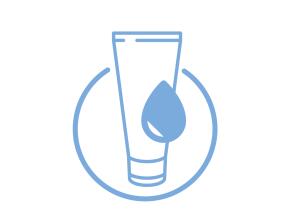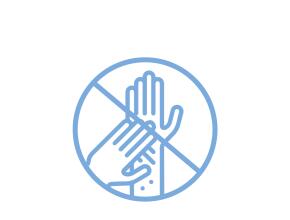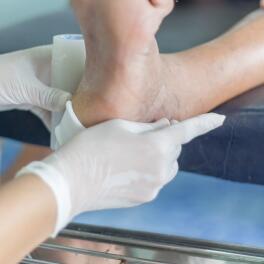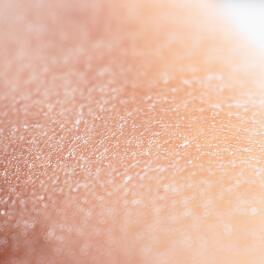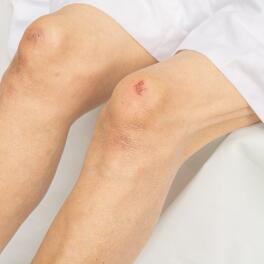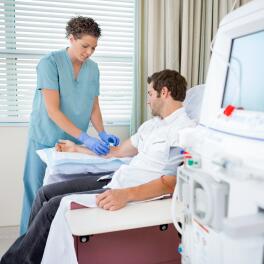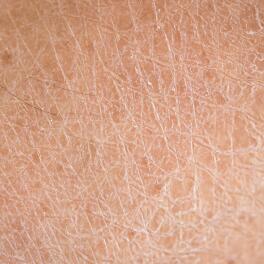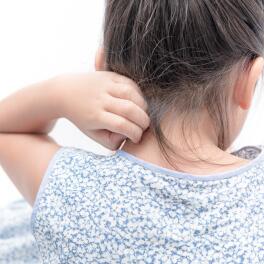How do you take care of your skin when you have cancer?
Cancer treatments can cause changes to the skin and nails. While skin problems caused by radiotherapy and chemotherapy are often mild, they can be bothersome and affect the quality of life of patients1,2. But what are chemotherapy and radiotherapy? What are the side effects of these treatments on the skin? And how can you take care of your skin to limit their occurrence?
- 50%
of cancer patients are treated with radiotherapy
- 95%
of patients treated with radiotherapy may develop skin erythema
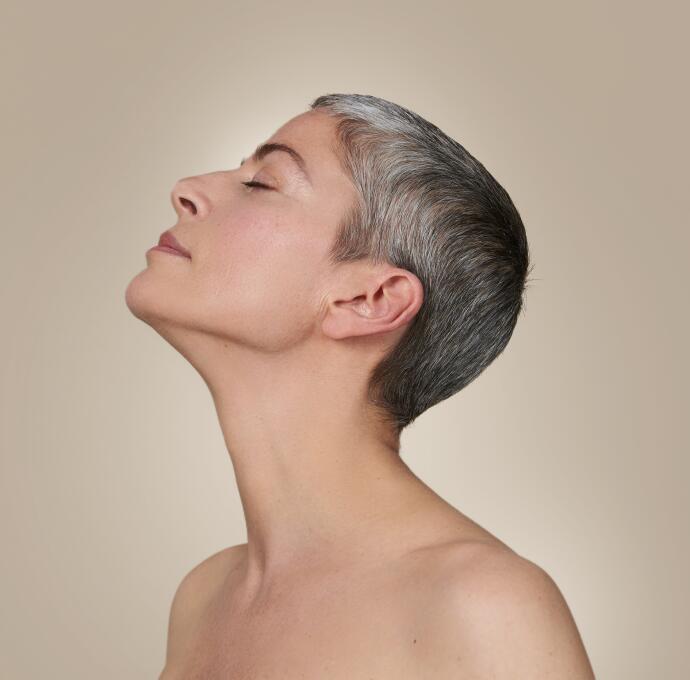
Summary
What is chemotherapy?
Chemotherapy is a drug treatment that aims to stop the growth of cancer cells. It acts either by killing these cells or by preventing them from multiplying3.
Chemotherapy can be given orally, by injection or infusion, or on the skin, depending on the protocol chosen for the type and stage of cancer being treated. It can be combined with other therapies such as surgery, radiotherapy or biological therapy3. Chemotherapy should not be confused with other cancer treatments such as targeted therapy, hormone therapy or immunotherapy4.
Chemotherapy works with the cell cycle. In fact, each time a new cell divides to form two functional cells, it goes through a process involving a series of phases: the cell cycle. Chemotherapies target cells at different stages of the cell cycle.
Cancer cells tend to divide to form new cells faster than healthy cells, making them a prime target for chemotherapy. Unfortunately, chemotherapy drugs do not distinguish between normal and cancerous cells. Healthy cells are, therefore, damaged along with the cancer cells, causing side effects4.
What is radiotherapy?
Radiotherapy is a treatment that uses radioactive radiation to destroy cancer cells. It works by preventing cancer cells from multiplying5. It is a locoregional cancer treatment, i.e. it only acts on a limited area of the body6. More than one in two patients treated for cancer receive radiotherapy at some stage of their treatment5.
There are several types of radiotherapy5:
- External radiotherapy: the rays are directed at the area of the body to be treated. The rays penetrate the skin to reach the cancer cells.
- Brachytherapy: where the radioactive source is directly in contact with the area to be treated.
- Metabolic radiotherapy: the radioactive elements are ingested orally or administered intravenously.
When irradiating a tumour, it is impossible not to irradiate, even partially, the surrounding tissue and, therefore, damage non-cancerous cells. This also applies to external radiation therapy, where the radiation passes through healthy tissue such as the skin7.
What are the side effects of cancer treatments?
There are many side effects of chemotherapy and radiotherapy due to the lack of specificity in the cells targeted by these treatments. In fact, they target healthy cells almost as much as cancer cells.
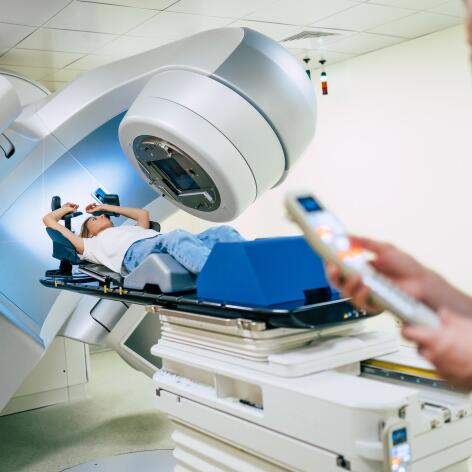
The impact of chemotherapy on the skin
The skin is not spared from this and certain chemotherapies can cause temporary changes to your skin8: dryness, discolouration, photosensitivity, i.e. increased sensitivity to light and in particular to the sun's rays, redness, pain, itching
Chemotherapy can also cause nails to become brittle or scaly, cracked, and cuticles can become painful1,8.
The impact of radiotherapy on the skin
Radiotherapy can cause dryness and shedding of the skin (i.e. the skin peels) on the part of the body that receives the radiation.
This may be associated with pruritus (itching) and redness of the area.
The skin looks like it has been badly sunburned, but it may also be swollen or puffy1. This is known as radiodermatitis or radiation dermatitis. These symptoms tend to appear one to two weeks after starting the treatment9. It is estimated that 95% of patients receiving radiotherapy will develop some form of radiodermatitis, including erythema (redness) or skin shedding10.
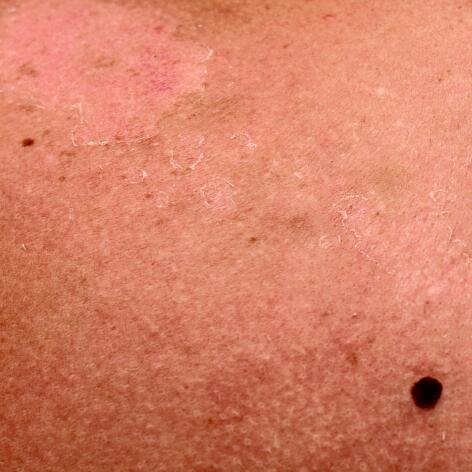
There are two types of radiodermatitis¹¹:
- Acute: skin lesions are caused by radiation and appear within 90 days of the start of treatment. It can last for more than four weeks.
- Chronic: lesions appear after 90 days. They may even appear several months or even years after completing radiotherapy. Fibrosis (hardening and loss of elasticity)12, telangiectasias, which are dilated blood capillaries13, skin atrophy, an "orange peel" appearance, anhydrosis, which is an absence of perspiration14 and skin dryness can all be observed.
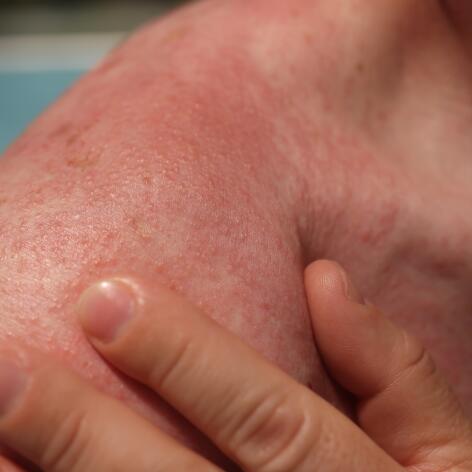
OUR ADVICE
Dab to dry
Protect your skin from climatic aggressors
How do you take care of your skin when undergoing chemotherapy or radiotherapy?
Most of the time, prevention is the best way to manage skin problems2 related to chemotherapy and/or radiotherapy treatment.
Simple steps and daily skin care will minimise the side effects on the skin induced by chemotherapy and the occurrence of radiodermatitis15 :
- Avoid products that are irritating to the skin. This includes washing products containing soap and all scented products2
- Gently dry by dabbing the skin with a towel rather than rubbing it
- Use, at least twice a day and within 15 minutes of showering, a specifically formulated emollient to properly and durably hydrate the skin2. The emollient should be applied some time before or after the radiotherapy sessions (at least four hours before)
OUR TIPS FOR CARING FOR YOUR SKIN WHEN UNDERGOING CHEMOTHERAPY OR RADIOTHERAPY
Wear appropriate clothing
Protect your skin from the sun
Do not scratch
- Wear loose-fitting clothing made with soft fabrics such as soft cotton and avoid rough wool or synthetic fibres.
- Do not shave or pluck affected areas of skin until they have healed. Use an electric shaver if necessary
- Protect your skin from the sun by applying SPF 50+ sun protection and wearing a wide-brimmed hat, protective clothing and sunglasses, and trying to stay in the shade. Avoid going out between 12 and 4 pm, when the sun is at its highest point
- Avoid chlorinated swimming pools as the water can aggravate skin changes
- In case of itching, avoid scratching as much as possible
If in doubt, it is important to consult your oncologist or general practitioner as soon as possible.
DEXERYL Emollient Cream can support you during a treatment
Prevention is important to avoid skin disorders related to chemotherapy and/or radiotherapy2. This involves daily nourishment and hydration of the skin and proper hygiene2.
DEXERYL supports you with emollient skin care and specially formulated cleansers.

DEXERYL Emollient Cream
It can be used to protect the skin and reduce the signs and symptoms of dry skin
It contains three active ingredients
- Glycerol for its hydrating action
- Vaseline and paraffin for their protective role

Dexeryl supports you each day
Sources:
- https://www.cancer.gov/about-cancer/treatment/side-effects/skin-nail-changes
- https://www.cancer.net/coping-with-cancer/physical-emotional-and-social-effects-cancer/managing-physical-side-effects/skin-conditions
- https://www.cancer.gov/publications/dictionaries/cancer-terms/def/chemotherapy
- https://www.cancer.org/treatment/treatments-and-side-effects/treatment-types/chemotherapy/how-chemotherapy-drugs-work.html
- https://www.e-cancer.fr/Patients-et-proches/Se-faire-soigner/Traitements/Radiotherapie
- https://www.cnrtl.fr/definition/locoregional
- https://www.e-cancer.fr/Patients-et-proches/Se-faire-soigner/Traitements/Radiotherapie/Effets-secondaires/Peau
- https://www.nhs.uk/conditions/chemotherapy/side-effects/
- https://www.nhs.uk/conditions/radiotherapy/side-effects/
- Manni Singh, Afsaneh Alavi et al: Radiodermatitis: A Review of Our Current Understanding; Am J Clin Dermatol 2016 Jun17(3): 277-92
- https://www.afsos.org/wp-content/uploads/2016/09/2014-12-12-_J2R_tox_cutanee_radioinduite_VF.pdf
- https://www.e-cancer.fr/Dictionnaire/F/fibrose
- https://www.e-cancer.fr/Dictionnaire/T/telangiectasie
- https://www.larousse.fr/dictionnaires/francais/anhidrose/3557
- https://www.cancercouncil.com.au/cancer-information/cancer-treatment/chemotherapy/side-effects/skin-and-nail-changes/



